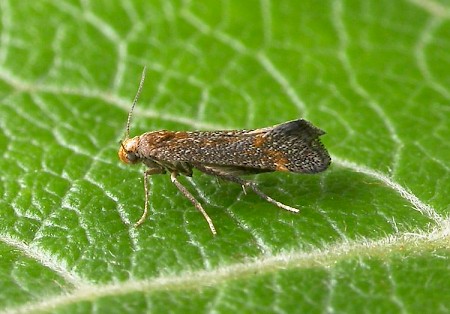35.06 BF730
Apodia bifractella
(Duponchel, [1843])
Wingspan 9-12 mm.
Widespread in southern England and also in N.W.England and N. Wales. The imago, July-August, is secretive, but is sometimes found in late afternoon on flowers of foodplant.
Larva, October to April, and pupa, May to June, in seedheads of common fleabane (Pulicaria dysenterica), ploughman's spikenard (Inula conyzae), or sea aster (Aster tripolium). There are no external feeding signs.
The easiest way to find Apodia bifractella is to note locations in summer where the foodplants grow, and to return in December to April to collect a carrier bag of the dead plant remains. Keep outdoors until March/April, and then bring inside, remove seedheads and place them in a large sweet jar, or similar, with the lid on. Imagines may emerge in July-August, but need careful looking for, as they sit very still and match the seedheads. If you think you have failed, check the debris at the bottom of the jar before discarding it.
Collecting seedheads at random may seem unreliable, but the first records for Cheshire and Derbyshire were made by collecting common fleabane at four widely separated localities, all of which produced A.bifractella, in one case, over 70 specimens. It is suspected that it may be common wherever the foodplants occur.
Larva: (description Ian F. Smith)
Foodplant: Seeds of Pulicaria dysenterica, Inula conyza and Aster tripolium October to April. In winter, in 6mm long, tough brown crescent shaped hibernaculum made of chewed seeds with whole seeds welded to sides, thinly lined with silk, and firmly attached to receptacle.
Length: 2.5 to 3mm in December.
Head: Off-white, very slightly more yellowish than body. Cuticle transparent. Clypeus and small labrum transparent, colourless. Mandibles brown with dark brown teeth. Frons thinly edged brown. Band of brown across anterior of capsule. Spinnerets faintly brown. Two dark brown stemmata on each side of head.
Thorax: Off-white, concolorous with abdomen.
Prothoracic shield: Barely differentiated from rest of body.
Thoracic legs: None
Body: Shaped as Diptera larva. Translucent, off-white. Greasy appearance. Very soft.
Spiracles: Burnt ochre.
Abdominal pinacula: Indiscernible.
Setae: Colourless transparent, curved. Most numerous and prominent, appearing ochre or blackish in some lighting, on segment A10, anal prolegs and head.
Anal plate: Barely differentiated.
Prolegs: None, except pair of vestigial anal prolegs clasped together and projecting from posterior of body.
Comment: To find over-wintering larvae, pull pappus off seed head. Most of it will come away easily with seeds attached, but if a larva is present, the hibernaculum will remain on the receptacle. Carefully break open the hibernaculum at both ends with a pin, and gently prod the larva out with the head of the pin.
To raise imagines, do not break open hibernaculum. Keep seed heads exposed to weather, but protected from birds until June. Then bring inside in a clear container for emergence. The imagines are well camouflaged, move little and are easily overlooked among the seed heads. Remove all stalks to reduce the amount of cover in the container.

 UKMoths
UKMoths 






